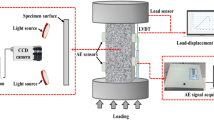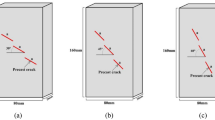Abstract
In order to understand the nonlinear characteristics of granite after exposure to high temperature, fracture tests were carried out. The fracture process of granite was monitored by combining digital image correlation (DIC) method and acoustic emission (AE) technology, and the changes of microcracks in granite after high-temperature treatment were observed. The apparent fracture toughness of granite decreased significantly after high-temperature treatment and showed obvious size effect, which is consistent with the size effect law of Bažant. The combined observations by DIC and AE showed that the crack of granite at room temperature started to grow significantly only when it approached the failure load, and the fracture process was rapid. However, the crack growth was observed clearly in the early stage of loading for the granite subjected to high temperature, and the process was slow and persistent. After granite was heated at high temperature, the critical crack tip opening displacement (CTODc), AE b value, effective fracture process zone length, and many other indicators all increased significantly. This indicates that the fracture types of granite changed from brittle to ductile. The microscopic results showed that the granite microcracks developed after high-temperature treatment, the number of microcracks increased significantly, and the porosity and fractal dimension increased. Finally, the relationship between work of cohesion and cumulative AE counts was estimated based on the fictitious crack model. The results showed that there was a significant linear correlation between the two variables, regardless of room temperature granite or heat-treated granite. The work of cohesion can characterize the activity of microcracks in the fracture process zone and it can be quantified by AE technology. This provides a new way to study crack propagation by AE technology.




















Similar content being viewed by others
References
Adamson, R. M., Dempsey, J. P., & Mulmule, S. V. (1996). Fracture analysis of semi-circular and semi-circular-bend geometries. International Journal of Fracture, 77(3), 213–222.
Bažant, Z. P. (2002). Concrete fracture models: Testing and practice. Engineering Fracture Mechanics, 69(2), 165–205.
Bhowmik, S., & Ray, S. (2019). An experimental approach for characterization of fracture process zone in concrete. Engineering Fracture Mechanics, 211, 401–419.
Carloni, C., Santandrea, M., & Baietti, G. (2019). Influence of the width of the specimen on the fracture response of concrete notched beams. Engineering Fracture Mechanics, 216, 106465.
Chen, Y. L., Wang, S. R., Ni, J., Azzam, R., & Fernandez-Steeger, T. M. (2017). An experimental study of the mechanical properties of granite after high temperature exposure based on mineral characteristics. Engineering Geology, 220, 234–242.
Dutler, N., Nejati, M., Valley, B., Amann, F., & Molinari, G. (2018). On the link between fracture toughness, tensile strength, and fracture process zone in anisotropic rocks. Engineering Fracture Mechanics, 201, 56–79.
Fan, B., Qiao, Y., & Hu, S. (2020). Evaluation of tension softening curve of concrete at low temperatures using the incremental displacement collocation method. Engineering Fracture Mechanics, 226, 106878.
Funatsu, T., Seto, M., Shimada, H., Matsui, K., & Kuruppu, M. (2004). Combined effects of increasing temperature and confining pressure on the fracture toughness of clay bearing rocks. International Journal of Rock Mechanics and Mining Sciences, 41(6), 927–938.
Garg, P., Hedayat, A., & Griffiths, D. V. (2020). Numerical simulation of fracture initiation in barre granite using an experimentally validated XFEM Model. In 54th US rock mechanics/geomechanics symposium. OnePetro.
Ghasemi, S., Khamehchiyan, M., Taheri, A., Nikudel, M. R., & Zalooli, A. (2019). Crack evolution in damage stress thresholds in different minerals of granite rock. Rock Mechanics and Rock Engineering, 53(3), 1163–1178.
Guo, T. Y., Wong, L. N. Y., & Wu, Z. (2021a). Microcracking behavior transition in thermally treated granite under mode I loading. Engineering Geology, 282, 105992.
Guo, Z., Li, J., Song, Y., He, C., & Zhang, F. (2021b). The size effect and microstructure changes of granite after heat treatment. Advances in Materials Science and Engineering, 2021, 9958255.
Kataoka, M., Obara, Y., Vavro, L., Soucek, K., Cho, S. H., & Jeong, S. S. (2019). Effect of testing method type and specimen size on mode I fracture toughness of Kimachi sandstone. Journal of MMIJ. https://doi.org/10.2473/journalofmmij.135.33
Kumari, W. G. P., Ranjith, P. G., Perera, M. S. A., Chen, B. K., & Abdulagatov, I. M. (2017). Temperature-dependent mechanical behaviour of Australian Strathbogie granite with different cooling treatments. Engineering Geology, 229, 31–44.
Kuruppu, M. D., Obara, Y., Ayatollahi, M. R., Chong, K. P., & Funatsu, T. (2014). ISRM-suggested method for determining the mode I static fracture toughness using semi-circular bend specimen. Rock Mechanics and Rock Engineering, 47(1), 267–274.
Li, J., Du, Z. W., & Guo, Z. P. (2020). Effect of high temperature (600° C) on mechanical properties, mineral composition, and microfracture characteristics of sandstone. Advances in Materials Science and Engineering, 2020, 5072534.
Li, J., Guo, Z., Ai, D., Yang, J., & Wei, Z. (2021). A simplified estimation method for tensile softening curve of quasi-brittle materials. Mechanics of Advanced Materials and Structures. https://doi.org/10.1080/15376494.2021.1991060
Limin, W., Xia, L., Shilang, X., Haiying, W., & Zhaojun, Z. (2018). Micro-crack damage in strip of fracture process zone. International Journal of Solids and Structures, 147, 29–39.
Lin, Q., & Labuz, J. F. (2013). Fracture of sandstone characterized by digital image correlation. International Journal of Rock Mechanics and Mining Sciences, 60, 235–245.
Liu, W., Chen, J., Guo, Z., Yang, H., Xie, W., & Zhang, Y. (2021). Mechanical properties and damage evolution of cemented coal gangue-fly ash backfill under uniaxial compression: Effects of different curing temperatures. Construction and Building Materials, 305, 124820.
Mahanta, B., Singh, T. N., & Ranjith, P. G. (2016). Influence of thermal treatment on mode I fracture toughness of certain Indian rocks. Engineering Geology, 210, 103–114.
Maruvanchery, V., & Kim, E. (2020). Effects of a high temperature (500 C) on the fracture processes in calcite-cemented sandstone along bedding-plane orientations. Rock Mechanics and Rock Engineering, 53(2), 955–966.
Miao, S., Pan, P. Z., Yu, P., Zhao, S., & Shao, C. (2020). Fracture analysis of Beishan granite after high-temperature treatment using digital image correlation. Engineering Fracture Mechanics, 225, 106847.
Moazzami, M., Ayatollahi, M. R., & Akhavan-Safar, A. (2020). Assessment of the fracture process zone in rocks using digital image correlation technique: The role of mode-mixity, size, geometry and material. International Journal of Damage Mechanics, 29(4), 646–666.
Nasseri, M. H. B., Schubnel, A., & Young, R. P. (2007). Coupled evolutions of fracture toughness and elastic wave velocities at high crack density in thermally treated Westerly granite. International Journal of Rock Mechanics and Mining Sciences, 44(4), 601–616.
Peng, K., Lv, H., Zou, Q., Wen, Z., & Zhang, Y. (2020). Evolutionary characteristics of mode-I fracture toughness and fracture energy in granite from different burial depths under high-temperature effect. Engineering Fracture Mechanics, 239, 107306.
Qing, L.-B., Cao, J.-F., & Guan, J.-F. (2019). Experimental investigation of the concrete permissible damage scale based on the digital image correlation method. Engineering Mechanics, 36(10), 115–121.
Shao, Z., Tang, X., & Wang, X. (2021). The influence of liquid nitrogen cooling on fracture toughness of granite rocks at elevated temperatures: an experimental study. Engineering Fracture Mechanics, 246, 107628.
Shi, X., Mirsayar, M., Mukhopadhyay, A., & Zollinger, D. (2019). Characterization of two-parameter fracture properties of portland cement concrete containing reclaimed asphalt pavement aggregates by semicircular bending specimens. Cement and Concrete Composites, 95, 56–69.
Standard, J. C. I. (2003). Method of test for fracture energy of concrete by use of notched beam. JCI-S-001e2003, Japan Concrete Institute. https://doi.org/10.3151/coj1975.44.12_10
Standard, A. S. T. M. (2005). Standard test method for linear-elastic plane-strain fracture toughness KIc of metallic materials. ASTM Book of Standards. https://doi.org/10.1520/E0399-05
Su, R. K. L., Chen, H. H. N., & Kwan, A. K. H. (2012). Incremental displacement collocation method for the evaluation of tension softening curve of mortar. Engineering Fracture Mechanics, 88, 49–62.
Wang, J., Zuo, J., Sun, Y., & Wen, J. (2021). The effects of thermal treatments on the fatigue crack growth of Beishan granite: An in situ observation study. Bulletin of Engineering Geology and the Environment, 80(2), 1541–1555.
Wei, M. D., Dai, F., Xu, N. W., & Zhao, T. (2016a). Stress intensity factors and fracture process zones of ISRM-suggested chevron notched specimens for mode I fracture toughness testing of rocks. Engineering Fracture Mechanics, 168, 174–189.
Wei, M. D., Dai, F., Xu, N. W., Zhao, T., & Xia, K. W. (2016b). Experimental and numerical study on the fracture process zone and fracture toughness determination for ISRM-suggested semi-circular bend rock specimen. Engineering Fracture Mechanics, 154, 43–56.
Wu, J., Gao, J., Feng, Z., Chen, S., & Nie, T. (2020). Investigation of fracture process zone properties of mode I fracture in heat-treated granite through digital image correlation. Engineering Fracture Mechanics, 235, 107192.
Wu, Z., Rong, H., Zheng, J., Xu, F., & Dong, W. (2011). An experimental investigation on the FPZ properties in concrete using digital image correlation technique. Engineering Fracture Mechanics, 78(17), 2978–2990.
Xu, J., Kang, Y., Liu, F., Liu, Y., Wang, Z., & Wang, X. (2021). Mechanical properties and fracture behavior of flawed granite under dynamic loading. Soil Dynamics and Earthquake Engineering, 142, 106569.
Xu, S., Malik, M. A., Li, Q., & Wu, Y. (2016). Determination of double-K fracture parameters using semi-circular bend test specimens. Engineering Fracture Mechanics, 152, 58–71.
Xu, S., & Reinhardt, H. W. (1999). Determination of double-Determination of double-K criterion for crack propagation in quasi-brittle fracture Part I: Experimental investigation of crack propagation. International Journal of Fracture, 98(2), 111–149.
Yin, T., Li, Q., & Li, X. (2019). Experimental investigation on mode I fracture characteristics of granite after cyclic heating and cooling treatments. Engineering Fracture Mechanics, 222, 106740.
Yin, T., Wu, Y., Li, Q., Wang, C., & Wu, B. (2020). Determination of double-K fracture toughness parameters of thermally treated granite using notched semi-circular bending specimen. Engineering Fracture Mechanics, 226, 106865.
Yu, J., Lu, Z., & Chen, Q. (2015). Determination of the softening curve and fracture toughness of high-strength concrete exposed to high temperature. Engineering Fracture Mechanics, 149, 156–169.
Zhang, S., Wang, H., Li, X., Zhang, X., An, D., & Yu, B. (2021). Experimental study on development characteristics and size effect of rock fracture process zone. Engineering Fracture Mechanics, 241, 107377.
Zhao, Y. M., Feng, X. T., Jiang, Q., Han, Y., Zhou, Y. Y., Guo, H. G., & Shi, Y. E. (2021). Large deformation control of deep roadways in fractured hard rock based on cracking-restraint method. Rock Mechanics and Rock Engineering, 54(5), 2559–2580.
Zhuang, L., & Zang, A. (2021). Laboratory hydraulic fracturing experiments on crystalline rock for geothermal purposes. Earth-Science Reviews, 216, 103580.
Zuo, J., Li, Y., Zhang, X., Zhao, Z., & Wang, T. (2018). The effects of thermal treatments on the subcritical crack growth of Pingdingshan sandstone at elevated high temperatures. Rock Mechanics and Rock Engineering, 51(11), 3439–3454.
Zuo, J. P., Wang, J. T., Sun, Y. J., Chen, Y., Jiang, G. H., & Li, Y. H. (2017). Effects of thermal treatment on fracture characteristics of granite from Beishan, a possible high-level radioactive waste disposal site in China. Engineering Fracture Mechanics, 182, 425–437.
Acknowledgments
This work was funded by the Natural Science Research Project of Department of Education of Guizhou Province, China (Project No. Qianjiao He KY [2020]118; [2018]380) and the Fund of Department of Science and Technology of Guizhou Province (Project No. [2019]1291; [2019]5620; [2014]7457) and the Fund of Department of Education of Guizhou Province (Project No. XKTJ[2020]23; [2016]02; [2012]017; [2018]029).
Author information
Authors and Affiliations
Corresponding author
Ethics declarations
Conflict of Interest
The authors have no competing interests to declare that are relevant to the content of this article.
Rights and permissions
About this article
Cite this article
Li, J., Guo, Z., Ai, D. et al. Nonlinear Characteristics of Granite After High-Temperature Treatment Captured by Digital Image Correlation and Acoustic Emission Technology. Nat Resour Res 31, 1307–1327 (2022). https://doi.org/10.1007/s11053-022-10048-5
Received:
Accepted:
Published:
Issue Date:
DOI: https://doi.org/10.1007/s11053-022-10048-5




